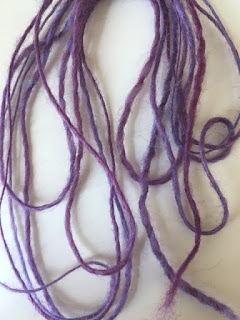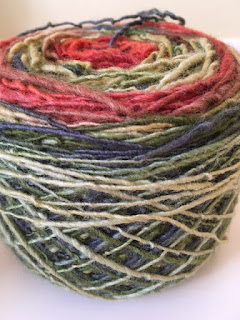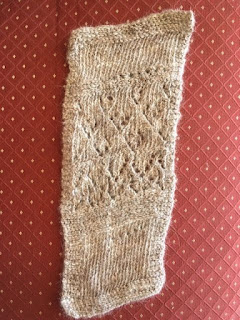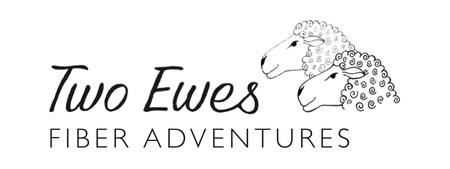What are singles?
A singles yarn is a yarn that is only one ply. Most of the time spinners make yarn with the intention to ply it. Most often spinners will make a two-ply yarn or a three-ply yarn. But there are times when a one-ply yarn, a singles yarn, is useful. Some well known examples of singles in commercial yarn are Tosh Merino Light and Lopi yarns.
Twist and Energy
When twist is introduced into the fibers, it can be thought of as energy. That energy can be seen to "balance" itself when a newly twisted yarn hangs free and it twists back on itself and stablilizes. When fiber is twisted into a singles and then it is made to stay that way for some time it will seem to stabilize without twisting back on itself. However, if soaked in water, the energy will be visible again. The yarn will, once again, twist back on itself. It's similar to the way hair that is curled or straightened with heat or time in curlers will return to it's original form once wet.
To Ply or Not to Ply
Plying a yarn can balance the energy, it can overbalance and add more energy if the yarn is over-plied or it can under-balance the energy, creating under-plied yarn. Balancing the energy is one way to make the yarn more manageable for knitting or crocheting. It is difficult to work with a highly energized or twisted yarn.
Here are some reasons that plying is a good idea:
- More balanced yarn (less energy, easier to work with)
- Stronger yarn
- Less pilling/harder wearing
- Color effects (fractal plying, barber-poling)
- To get a larger yarn
There are some ways other than plying to tamp down the energy in a singles and make it manageable to knit or crochet. This opens up the possibility of using singles in a project.
Here are some reasons to use singles:
- Colors stay clear--not muddied or barber-poled
- Faster!
- Lighter yarn (even for the same thickness)
- Different texture than plied yarn
- Energy of yarn can be used to advantage
My Experiment
I wanted to use several different kinds of singles and document the process of using them for knitting. I swatched with four different yarns.
Well-aged singles. This was purposely spun as a low-twist worsted singles, using the slowest whorl on my wheel. The fiber was Blue-Faced Leicester from Wool Gatherings' fiber club (2014). The yarn was about sport weight. When wound from the wheel into a skein it was kinky, but after washing it wasn't highly energized. There were no bends or kinks left in yarn. It had been washed a little harshly, with agitation in hot water and soap, to slightly full the yarn. This yarn had been wound into a center-pull ball about two years ago. Re-soaking a bit of the yarn didn't result in a more twisty or energized yarn.
 |
| BFL singles: spun, washed, and wound. |
 |
| After re-soaking, this yarn was still low energy. |
Newly spun singles. These were intended to be spun at the same size and twist as the yarn above. However, while spinning, I sometimes got distracted and didn't always achieve the low twist that was planned. The fiber was Polwarth from Wool Gatherings fiber club (2014). It was extremely kinky when wound into skein directly off the wheel. This yarn was washed fairly gently—with no intent to full it. The yarn still had kinks when dry but hung fairly straight, with only a loose twist in the hank.
 |
| Polwarth singles right off the wheel. |
 |
| Polwarth singles after a gentle washing. |
 |
| Wound with a little tension after washing |
Alpaca singles. These were also newly spun for the swatching project. It was about DK weight, spun in a semi-worsted style with a relatively low twist. It was very kinky when taken off the wheel. I washed it gently, so it was not fulled. The yarn still had some kinked areas after washing, but it hung with only a loose twist in the hank.
 |
| Alpaca singles unwashed (top) and washed (bottom) |
 |
| Another view of the alpaca singles after washing. |
Aged CVM singles. These woolen-style singles were wound from the wheel to a center pull ball in early 2016. The yarn is a worsted to aran weight, not consistent in its grist, and spun woolen on the Ricci Indian Head Spinner. This wheel has tremendous draw in and I am still getting accustomed to it to the yarn was a very low twist singles. The fiber was a carded preparation of California Variegated Mutant (CVM). The yarn was not washed prior to using and since it was in a ball, I never saw how it would hang in a hank.
 |
| CVM singles--very inconsistent |
The Swatches
Swatches were photographed before and after washing. The swatches were not blocked, just laid out flat to dry.
Well-aged singles swatch:
Size 3 needles, garter stitch border and stockinette center. A little energy evident as buckling in unwashed swatch. After washing, no evident biasing or buckling. Light fabric with good stitch definition. Note how colors of the swatch are clear and not muddied or blended by plying.
 |
| Unwashed swatch buckles. |
 |
| Light and even after washing. |
Newly spun singles swatch:
Size 3 needles (bottom), some tension or buckling in the stockinette before washing. After washing, no evident biasing good stitch definition, sturdy feeling fabric, yarn looks even.
Size 5 needles (middle), slight energy visible in stitches both before and after washing. Swatch has texture. Can see some unevenness in yarn.
Size 7 needles (top), Energy visible in stitches, unevenness visible both before and after washing. Slight biasing. Fabric has great drape.
 |
| Before washing. |
 |
| Small and medium gauge before washing. |
 |
| Medium and large gauge before washing. |
 |
| After washing. |
 |
| Small and medium gauge after washing. |
 |
| Medium gauge after washing. |
 |
| Large gauge after washing. |
Alpaca singles swatch:
Size 4 needles (bottom). Before washing, definite bias. After washing, slight bias in stockinette, nice fabric weight. Not as heavy or dense feeling as my alpaca yarn has been in past. After washing, yarn looks fairly even in stockinette, less so in garter.
Size 7 needles (all other sections). Before washing, definite bias. After washing, fabric has nice drape with light biasing in stockinette. Also some energy visible in stitches. Two lace patterns done in size 7 also. Both are pleasing, no biasing evident after washing , stitches look even and organized but some YOs are consistently smaller. Pattern probably looks slightly different than it would in plied yarn.
 |
| Alpaca before washing. |
 |
| Alpaca after washing. |
 |
| Small gauge after washing. |
 |
| Lace and larger gauge after washing. |
 |
| Lace and garter after washing. Notice unevenness of garter. |
|
Aged CVM singles swatch: Size 10 needles. Fluffy and light. No biasing, but a little buckling before washing. Used stockinette and basketweave pattern (alternating k2P2 for two rows then P2K2 for two rows). Stitch definition not clear. Unevenness of yarn not really evident in stockinette, very evident in garter stitch.
 |
| CVM before washing. |
 |
| CVM after washing. |
Final Thoughts
I hope you have enjoyed this adventure in knitting with handspun singles! The lesson I learned here is that singles can be a great yarn to work with--especially if they are intentionally spun with a little less twist than usual. Of course, swatching is a great idea! It will give you an idea of the strengths and weaknesses of the yarn you have created. It will also give you a better sense of what the final product will look like. Along the way, before washing, things might look a little "wonky." I am now interested to try some crochet with handspun singles!
If you do some of your own experiments with singles, please let us know your thoughts! You can post in the comments or in our
Ravelry Group! Or email us at twoewesdyeing@gmail.com Happy spinning!






